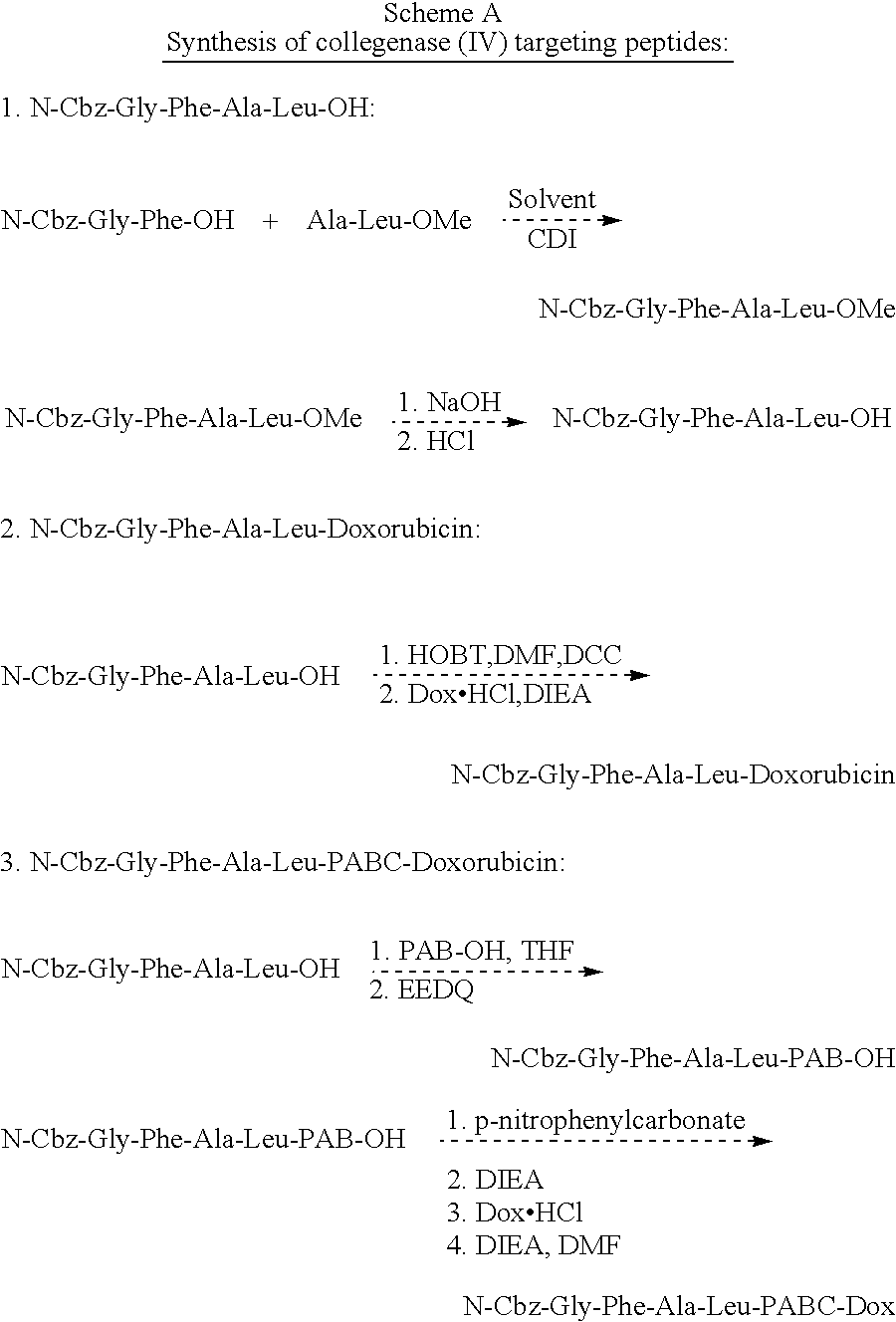Enzyme-activated anti-tumor prodrug compounds
a technology of prodrug compounds and enzymes, applied in the field of prodrug compounds, can solve the problems of poor prognosis, difficult treatment of metastatic tumors, and no dose-effective treatment of solid tumors
- Summary
- Abstract
- Description
- Claims
- Application Information
AI Technical Summary
Problems solved by technology
Method used
Image
Examples
example 1
[0039] N-Cbz-Gly-Phe-Ala-Leu-OH:
[0040] N-Cbz-Gly-Phe-OH (5.0 g, 0.0057 mol) was dissolved in THF (60 ml) in a 250 ml round bottom flask. Under positive dinitrogen pressure, carbonyldiimidazole (2.55 g, 0.0057 mol) was added at once. The solution was stirred 40 minutes at room temperature. Ala-Leu-OMe.HC; (4 g, 0.057 mol) was weighed out in a separate vial and dissolved in 5 ml of THF. N,N-Diisopropylethylamine, (2.73 ml, 0.057 g) was added and the resulting viscous oil was added to the first flask via syringe. Mild warming and a greenish blue color was noted. The flask was stirred for 24 hours, after which it was quenched with 10% citric acid and the product extracted with ethyl acetate. The ethyl acetate was removed in vacuo and N-Cbz-Gly-Phe-Ala-Leu-OMe (7.2 g) was isolated as a white solid.
[0041] The methyl ester was dissolved in methanol (20 ml) and isopropanol (30 ml) and placed in an ambient temperature bath. A solution of 1 M NaOH (12 ml) was added, and the reaction was stirr...
example 2
[0042] N-Cbz-Gly-Phe-Ala-Leu-Doxorubicin:
[0043] N-Cbz-Gly-Phe Ala-Leu-OH (204 mg, 0.377 mmol) was weighed out and placed in a 100 ml round bottom flask. N-hydroxybenzotriazole (HOBT) (51 mg, 0.378 mmol) was added followed by DMF (10 ml). Dicyclohexylcarbodiimide (78 mg, 0.378 mmol) was weighed into a separate vial, dissolved in DMF (10 ml) and added to the solution, which was then stirred for 20 minutes at room temperature.
[0044] Into another separate vial, doxorubicin HCl (100 mg, 0.172 mmol) and N,N-diisopropylethylamine (33 .mu.l, 0.378 mmol) were dissolved and added via syringe to the peptide solution. The resulting solution was stirred overnight at room temperature. The reaction mixture was quenched with 10% citric acid solution and the product was extracted with diethyl ether (1 l). The diethyl ether was washed with saturated aqueous sodium bicarbonate (250 ml) and brine (500 ml). The organic extract was dried with anhydrous MgSO.sub.4 and the ether was removed in vacuo. The p...
example 3
[0045] N-Cbz-Gly-Phe-Ala-Leu-PABC-Doxorubicin:
[0046] N-Cbz-Phe-Ala-Leu-OH (3 g, 5.5 mmol) and p-aminobenzyl alcohol [PABOH] (0.684 g, 5.5 mmol) were weighed out and placed in a 100 ml 2 neck round bottom flask equipped with a stir bar. THF (25 ml) was added with stirring followed by EEDQ [1-ethyloxycarbonyl-2-ethyloxy-1,2-dihydro-quinoline] (1.37 g, 5.5 mmol). The reaction was quenched with 10% citric acid solution and the product was extracted with ethyl acetate.
[0047] The ethyl acetate layer was dried with MgSO.sub.4 and the solvent removed in vacuo. An amorphous white solid was isolated and used without further purification.
[0048] A scoop of molecular sieves were activated in the microwave, allowed to cool in vacuo, then placed under a nitrogen atmosphere. N-Cbz-Phe-Ala-Leu-PABOH (220 mg, 0.34 mmol) and p-nitrophenylcarbonate (150 mg, 0.49 mmol) were weighed out and added to the sieves under positive nitrogen pressure. Methylene chloride (40 ml) was added to the flask followed by...
PUM
| Property | Measurement | Unit |
|---|---|---|
| particle size | aaaaa | aaaaa |
| flow rate | aaaaa | aaaaa |
| adhesion | aaaaa | aaaaa |
Abstract
Description
Claims
Application Information
 Login to View More
Login to View More - R&D
- Intellectual Property
- Life Sciences
- Materials
- Tech Scout
- Unparalleled Data Quality
- Higher Quality Content
- 60% Fewer Hallucinations
Browse by: Latest US Patents, China's latest patents, Technical Efficacy Thesaurus, Application Domain, Technology Topic, Popular Technical Reports.
© 2025 PatSnap. All rights reserved.Legal|Privacy policy|Modern Slavery Act Transparency Statement|Sitemap|About US| Contact US: help@patsnap.com


